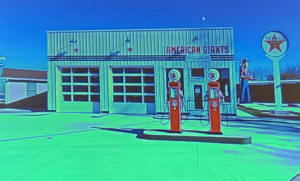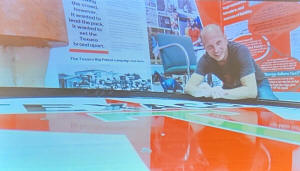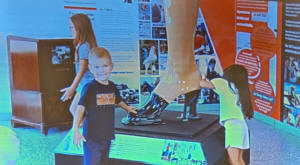|
Scott McCoy guest speaker at LCGHS
Annual Dinner
 Send a link to a friend
Send a link to a friend
[November 28, 2023]
The Logan County Genealogical and Historical Society
annual November dinner meeting was held at Daphne’s Restaurant with
a presentation by Atlanta Tourism Director Scott McCoy.

McCoy has worked in the tourism industry for 19 years
and was previously a mayor of Pontiac. When McCoy started serving as
mayor, he said Pontiac had no tourism whatsoever.
During McCoy’s time as mayor, he helped Pontiac develop Route 66
attractions including a museum. He has also created a Route 66
Ultimate Guide app, which is the number one app used. Currently
Scott and his wife Jennifer live in Bloomington.

Over the summer, McCoy helped set up the Atlanta
Giants Museum on Arch Street. Right now, there are several artifacts
inside the museum. A Texaco sign, Snerd, “the half-wit” giant and
two gas pumps are outside.
Atlanta’s water tower and Paul Bunyan Statue (AKA Hotdog Guy) draw
hundreds of visitors to Atlanta every month. McCoy said these types
of roadside attractions pull people in from all over the world who
are touring Route 66.
Elaborate signs have been used throughout the route to get people to
visit or stay in their towns. McCoy said some hotels had neon signs.
Cars were even placed on sticks. One leaning water tower was made
that way to attract people.
The giant statues are a class all their own. McCoy said some of
these statues are what were called the “Muffler Men” and they
originally held mufflers. Many hold other items like hot dogs or
rockets now. Newer statues have been modified to look like the old
ones.

A man named Joel Baker became fascinated by the
roadside giants and began to explore them, documenting and recording
them. Baker was trying to find out where the giants came from or how
they were modified. McCoy said Baker discovered some of these
artifacts had been lost, torn down or buried.
One day when Baker was using a GoPro on a stick to record in
Atlanta, he met Bill Thomas, who works with the Atlanta Betterment
Fund. Baker told Thomas about the Muffler Men he was trying to
restore to save Americana.
These giants were all in a warehouse in Southern Illinois and other
locations. Thomas said the Atlanta Betterment Fund could be used to
help do something with the giants and asked if Baker would bring his
giants to Atlanta if something was built. Baker said yes.
The American Giants Museum was built over an old 1960s era Texaco
gas station. It is in downtown Atlanta on Arch Street.

Years ago, McCoy said Texaco stations designed their
giant statues to look like station attendants who serviced cars. The
Texaco Big Friend is a complete redesign of the muffler man from
International Fiberglass in California.

All the giant statues were made of fiberglass and
were hollow, so they are not extremely heavy. McCoy said 300 of
these statues were built in the 1960s and moved around to various
stations to draw people from Route 66.
Because the statues were hollow, McCoy said some blew over, smashed
cars, broke windows in buildings or caused other problems, so the
giants were being latched down with ropes. Because of the problems,
McCoy said most of the giants were eventually destroyed. Only six of
the giants survived.
[to top of second column]
 |

The American Giants Museum is a project by three
entities: Joel Baker, the Atlanta Betterment Fund and the city of
Atlanta. It is created in the likeness of an old Texaco station.
McCoy said the Big Friend statue will be installed in spring 2024.
Last week, the gas pumps were delivered.
Though Snerd is the only giant now, McCoy said there will eventually
be five other giants. Four of the giant statues will be on platforms
near Snerd on the right side of the museum. The Big Friend statue
will be placed on the left side.
Snerd was brought in this past June. McCoy said
Snerd’s legs had to be completely rebuilt. Since Snerd arrived,
McCoy said the statue has become a sensation that attracts many
visitors from all over the world.

Artifacts like the Esso tiger, Uniroyal gal’s shoe
and A & W Root Beer mama and baby are inside the museum. McCoy said
the inside of the museum is still a work in progress. Kids and
adults are allowed to touch the artifacts, which is something McCoy
loves about the museum.
By setting up the museum, McCoy said the entities involved are
making something out of nothing. They are gearing up for the
upcoming 100th anniversary of Route 66, which will be in 2026.
Next, McCoy asked whether anyone had questions about the museum.
There was one question about whether they would rotate the items in
the museum. Others asked about the hours of the museum, whether
there is an entrance fee and whether they can get grant funding.

Eventually, McCoy said they will rotate some of the
items from Baker’s collection of artifacts.
This year, McCoy said the museum has had flexible hours from Tuesday
through Sunday. It is usually open from 10 to 4 or 10 to 6. He said
Saturday, Sunday and Monday tend to be the busiest travel days for
Route 66 tourism. There is no entrance fee.
Many people travelling Route 66 start in Chicago and are westbound.
McCoy said Route 66 tourism is a very unique industry.
There are some grants they can get from the state. McCoy said these
must be done through the Atlanta Betterment Fund using the city’s
name. He said Atlanta did not spend its tax dollars on the museum.
The city funding used came from the business district. McCoy said
money comes in from people travelling through.
In answer to a question about the restoration of the giants, McCoy
said Joel Baker and some of his friends are restoring them. The
giants are assembled and then transported to the sites where they
will be placed.
Someone asked how the fiberglass giants were destroyed.
McCoy said many of the Texaco giants were destroyed by being smashed
and were then put in landfills. The surviving ones have been
modified so much that McCoy said they do not even look like the
originals.
Kathy Horn, who is on the Atlanta City Council, serves as a
volunteer at the museum. She said they keep a guestbook and have
already had several thousand visitors.
Some tourists are specifically looking for giants, while others are
touring Route 66. McCoy said hundreds of thousands of people tour
Route 66 every year.
The Atlanta Giants Museum is predicted by many to be one of the top
ten to twelve spots on Route 66. McCoy said Route 66 is an untapped
resource for many communities.
When McCoy became the mayor in Pontiac, they had almost no tourism.
After the Route 66 Association began, McCoy said Pontiac tourism
took off. They went from zero tourism to 15,000 people a year. He
said now there are probably 60,000 people who visit Pontiac yearly.
Marketing is something McCoy said has helped increase Route 66
tourism. When people come to Atlanta, McCoy wants them to spend
money in town. He said many businesses had record months this past
season and the museum is not even fully on the map yet.
People often buy hats, shirts and other Route 66 memorabilia when
they visit Atlanta, which McCoy said is part of the white carpet
corridor of the route.
The museum and other places in Atlanta like the Hawes Elevator
Museum and Coal Mine Museum help promote the community. McCoy said
that is the purpose of tourism.
[Angela Reiners]
Related Links:
AtlantaIllinoisTourism.com |